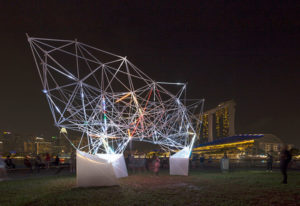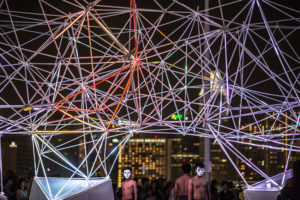SUTD Professors Unveil Mesh-Like 3D Printed Light Art Installation in Singapore
Just as 3D printing technology can be used to construct bridges, houses, and office buildings, it can also be used to construct artistic sculptures. Thanks to its ability to create custom, complex structures, 3D printing technology has helped artists around the world turn their ideas into actual works of sculptural art, from the biggest and smallest sculptures, to pieces inspired by shoes, music, death, cars, and everything in between. Two architecture professors from the Singapore University of Technology and Design (SUTD), Felix Raspall and Carlos Bañón, have been investigating the use of 3D printing for the construction of full-scale, functional architectural components, and recently erected and installed a tall, 3D mesh-like light art installation for Asia’s leading sustainable light art  festival, the iLight Marina Bay Festival, which was held in Singapore last month. The annual festival features light art installations from artists all over the world, which are designed with environmentally-friendly materials or energy-saving lighting, as the waterfront Marina Bay development is a sustainable precinct. The purpose is to encourage attendees to adopt sustainable habits in their daily lives. This year’s festival featured a total of 20 sustainable light art installations, including Bañón and Raspall’s structure. This isn’t their first experience with 3D printed mesh structures: last year, the two designed and installed a 3D printed fibrous mesh pavilion in the atrium of SUTD for an open house event. But the iLight Marina Bay Festival structure is pretty different: the ‘ultra light network’ is actually a 3D printed lightweight, light-emitting tetrahedral mesh. The structure is pretty large, at 10 x 6 x 3 m, and over 50,000 individually addressable LED pixels react to a special algorithm, which runs on five micro controllers and actually responds to a visitor’s presence, thanks to three ultrasonic sensors located at the three bases of the sculpture. So this actually allows visitors to enjoy an interactive light experience, made of polymers and backed by a beautiful skyline. Bañón and Raspall had help developing the structure: the project was actually developed by a multidisciplinary team at SUTD. Project leads included Bañón and Raspall, engineering professor Mohan
festival, the iLight Marina Bay Festival, which was held in Singapore last month. The annual festival features light art installations from artists all over the world, which are designed with environmentally-friendly materials or energy-saving lighting, as the waterfront Marina Bay development is a sustainable precinct. The purpose is to encourage attendees to adopt sustainable habits in their daily lives. This year’s festival featured a total of 20 sustainable light art installations, including Bañón and Raspall’s structure. This isn’t their first experience with 3D printed mesh structures: last year, the two designed and installed a 3D printed fibrous mesh pavilion in the atrium of SUTD for an open house event. But the iLight Marina Bay Festival structure is pretty different: the ‘ultra light network’ is actually a 3D printed lightweight, light-emitting tetrahedral mesh. The structure is pretty large, at 10 x 6 x 3 m, and over 50,000 individually addressable LED pixels react to a special algorithm, which runs on five micro controllers and actually responds to a visitor’s presence, thanks to three ultrasonic sensors located at the three bases of the sculpture. So this actually allows visitors to enjoy an interactive light experience, made of polymers and backed by a beautiful skyline. Bañón and Raspall had help developing the structure: the project was actually developed by a multidisciplinary team at SUTD. Project leads included Bañón and Raspall, engineering professor Mohan  Elara, postdoctoral SUTD researcher Felix Amtsberg, and Manual Garrido, who also designed the lights. A nine-person team led the research for the project, and Bond Optoelectronics supplied the LED lights for the installation. Project sponsors included Stratasys, SUTD, and the university’s Digital Manufacturing and Design Centre, which recently collaborated with the Hebrew University of Jerusalem to research and create stretchable, UV curable elastomers for 3D printing. A total of 715 slender tubes make up the light art installation, and are made of polymers; more specifically, polycarbonate squared tubes, which diffuse the light evenly, using translucent ABS and nylon materials which contain custom-made LED light bulbs. The team actually had to develop their own custom parametric tools to put up the flexible, resilient installation. Bañón and Raspall’s beautiful and captivating light network does what other existing systems can’t: it envelops a hyper-redundant element, which allows the installed structure to absorb outside stresses, like wind or other forces. The structure can actually respond in a fairly even pattern to contraction, expansion, and other loads.
Elara, postdoctoral SUTD researcher Felix Amtsberg, and Manual Garrido, who also designed the lights. A nine-person team led the research for the project, and Bond Optoelectronics supplied the LED lights for the installation. Project sponsors included Stratasys, SUTD, and the university’s Digital Manufacturing and Design Centre, which recently collaborated with the Hebrew University of Jerusalem to research and create stretchable, UV curable elastomers for 3D printing. A total of 715 slender tubes make up the light art installation, and are made of polymers; more specifically, polycarbonate squared tubes, which diffuse the light evenly, using translucent ABS and nylon materials which contain custom-made LED light bulbs. The team actually had to develop their own custom parametric tools to put up the flexible, resilient installation. Bañón and Raspall’s beautiful and captivating light network does what other existing systems can’t: it envelops a hyper-redundant element, which allows the installed structure to absorb outside stresses, like wind or other forces. The structure can actually respond in a fairly even pattern to contraction, expansion, and other loads.
Source: 3dprint.com










